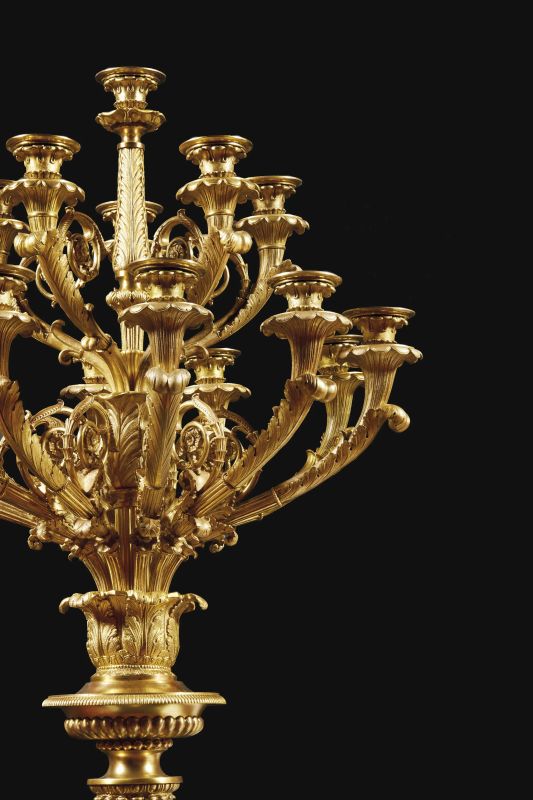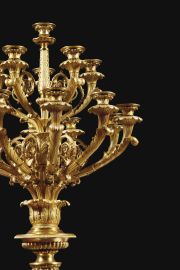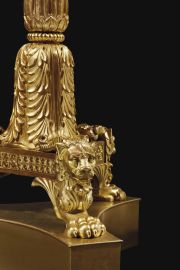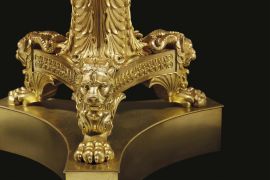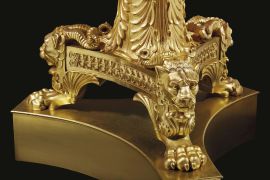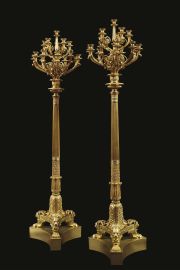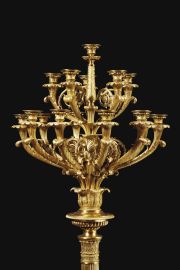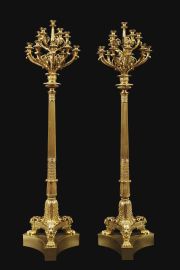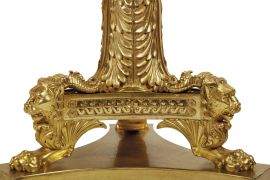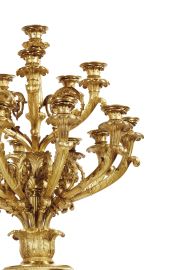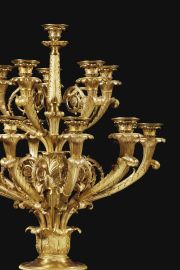A PAIR OF MONUMENTAL TORCHÈRES, LONDON, 1830 CA.
in gilded bronze. With a shaped triangular platform on which rest three winged ferine paws supporting the tripod stand, decorated at the corners with leonine masks with long ram’s horns and carved along the sides with recessed bands of repeating plant motifs, on which the base rests. The base is in the form of large acanthus leaves flaring open in a downward direction and caught at the top by a ring with baccellatura decoration; the grooved stem, tapering upward, which departs from this point, is sculpted at the bottom with repeats of long, upward-pointing leaves, followed by a band chiselled with repeats of small, overlapping lanceolate leaves and culminating in a capital with long lanceolate leaves; the narrow neck over the capital supports a disk, engraved with baccellature, which in turn supports a cup of flaring acanthus leaves from which there rise fourteen arms in the form of volutes, decorated with ramages of foliage on two orders and framing a central arm. Size: 250 x 62 x 62 cm.
This pair of monumental torchères finds numerous comparison pieces in the production of the English Regency era, when many exemplars from antiquity were rediscovered and were often taken as models and as sources of inspiration for the manufacturing of the time. In particular, while in France the merit for kindling interest in the forms adopted in ancient Rome goes to architects Charles Percier and Pierre François Léonard Fontaine and their Recueil de Décorations Intérieures (1801), in England, in 1814, Moses published the repertoire entitled Vases, Altars, Paterae, Tripods, Candelabra, Sarcophagi, a collection of studies and illustrations of ancient models, in many cases marbles displayed at the Louvre. And this was the point of departure for a fruitful and highly successful production that is witnessed today by several of the exemplars which have come down to us and which are comparable with the torchères we are proposing here. In detail, our torchère shows many similarities with works attributed to William Collins, both in the overall design and in choice of decorative motifs. Collins was active in London between 1808 and 1852; among his most important patrons and main clients was the third Duke of Northumberland to whom, from 1822 to 1839, Collins supplied the entirety of his lighting fixtures in both gilded and patinated bronze, including the ‘5 Altar Pedestals with 5 Lamps for Grand Staircase’ cited in an invoice dated 23 March 1823 (C. Sykes, Private Palaces: Life in the Great London Houses. New York 1986, p. 239), which share many features with our torchères. Production of this model continued even through the decades following the Regency era, during which time some small variations were introduced, such as – and our piece offers an example – the addition of arms at the upper extremities.
Francesco Larderel (see photo 1) was born François Jacques Larderel in Vienne, France, in 1789. During the Napoleonic era he moved to Livorno, where he was described in the 1814 almanacs as a ‘fancy-goods merchant’. But in the following fifteen years, he exploited the geothermic resources of the Volterra area to promote and develop the boric acid industry – and accumulated a considerable fortune. He started his boric acid venture in 1818, with Ana Gurliè and Francesco Prat and one extraction plant. French interests, centred in the Franco-Livornese communities, above all in his native region, and later on in Paris, capital of the French financial world, and English interests in Tuscany, joined Larderel and the expanding Tuscan company. Larderel’s 1830 purchase of two lots on what was then Via dei Condotti Nuovi to construct a four-storey residential palazzo (see photo 2), completed in 1832 at the cost of 70,000 Tuscan lire, marked the start of his social climb; the doors of the city nobility opened to him and his home became a centre of social and society life in the city. Embellished with exquisite furnishings and a collection of ancient and modern art, the palazzo carved for Larderel a place among the city’s art patrons and benefactors. In this connection, on 15 June 1858, having received news of Francesco de Larderel’s death, his fellow citizens of Livorno wrote that ‘in a city where commerce is everything, like Livorno, it is good to see the precious de Larderel gallery with its paintings and statues of our most illustrious ancestors’ and ‘if everyone perceived our country as did this Meritorious Citizen of Livorno, who of his own accord supported young engineers in studies of the “beautiful” in Florence and in Rome, who collected in such a brief time a rich and precious gallery with the intention of opening it to the public, the arts would have flowered more handsomely’. The de Larderel collection in the Livorno palazzo was soon one of the city attractions and was even touted to visitors: the 19th- and 20th-century tourist guides referred to it as one of the most worthwhile destinations on a tour of the city. Identification of the collection with the city was an established fact by 1874, when Riccardo Marzocchini published four photographs of the ‘Salotti e Gallerie’ of Palazzo de Larderel (see photo 3) in the volume entitled Album di vedute antiche e moderne di Livorno e dei suoi contorni. The palazzo and its collection reflect Francesco Larderel’s society career: by 1837 royal decree he was permitted to adopt the title of Count of Montecerboli, the locality in which he had ‘erected the grandiose borax plants’; not by chance, the de Larderel coat-of-arms carries the images of the fumaroles and the production plants (see photo 4). Besides with this title, which was later recognised as hereditary, de Larderel was named Cavaliere di San Giuseppe and also honoured with membership in the Casino di Nobili of Florence and the appointment of his son Enrico to the post of Royal Chamberlain (1851). De Larderel thus gained admittance to the grand ducal court and consequently, the chance for his heirs to marry into families of great prestige and ancient nobility, such as the Rucellais and the Salviatis, and finally the House of Savoy: in 1872, Francesco’s granddaughter Bianca married the morganatic son of the king of Italy, Emanuele Alberto, Count of Mirafiori.
Comparative literature
L. Frattarelli Fischer, M.T. Lazzarini (eds.), Palazzo de Larderel a Livorno. La rappresentazione di un’ascesa sociale nella Toscana dell’Ottocento. Milano 1992.


